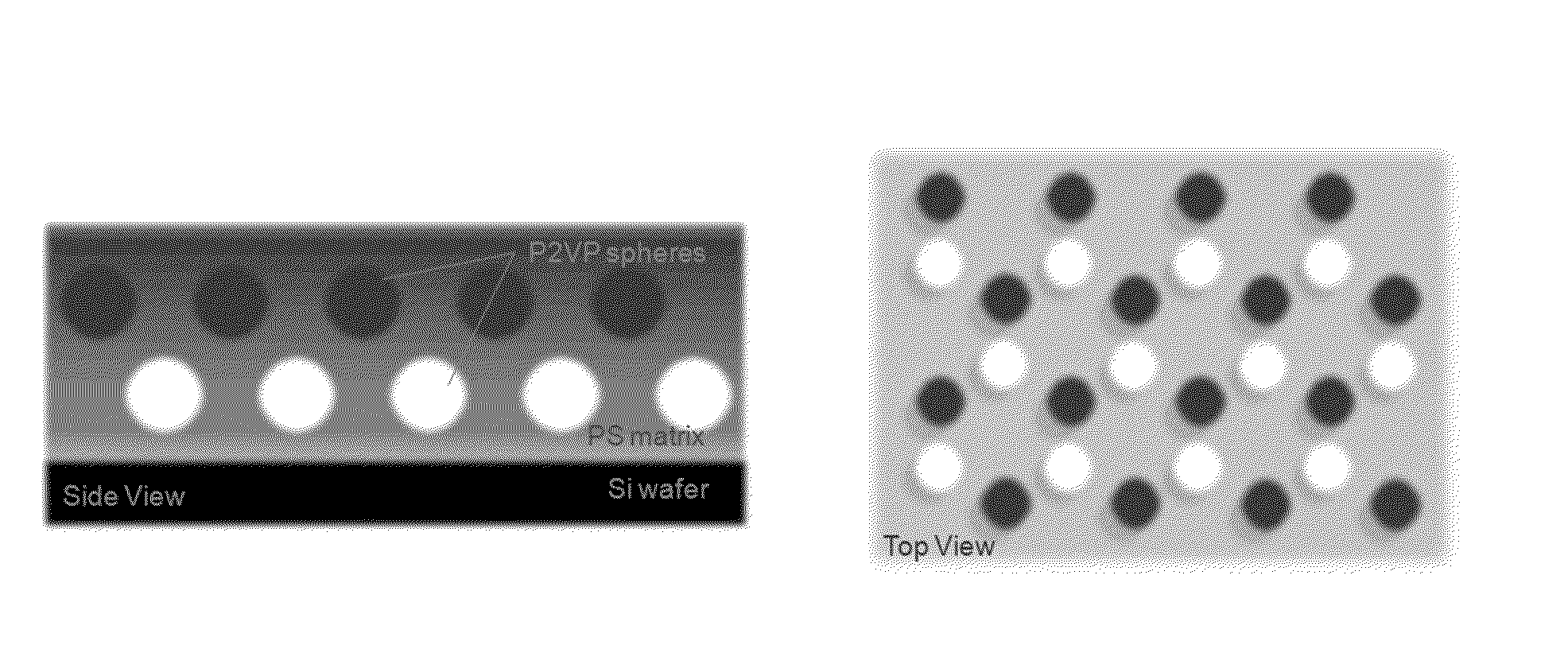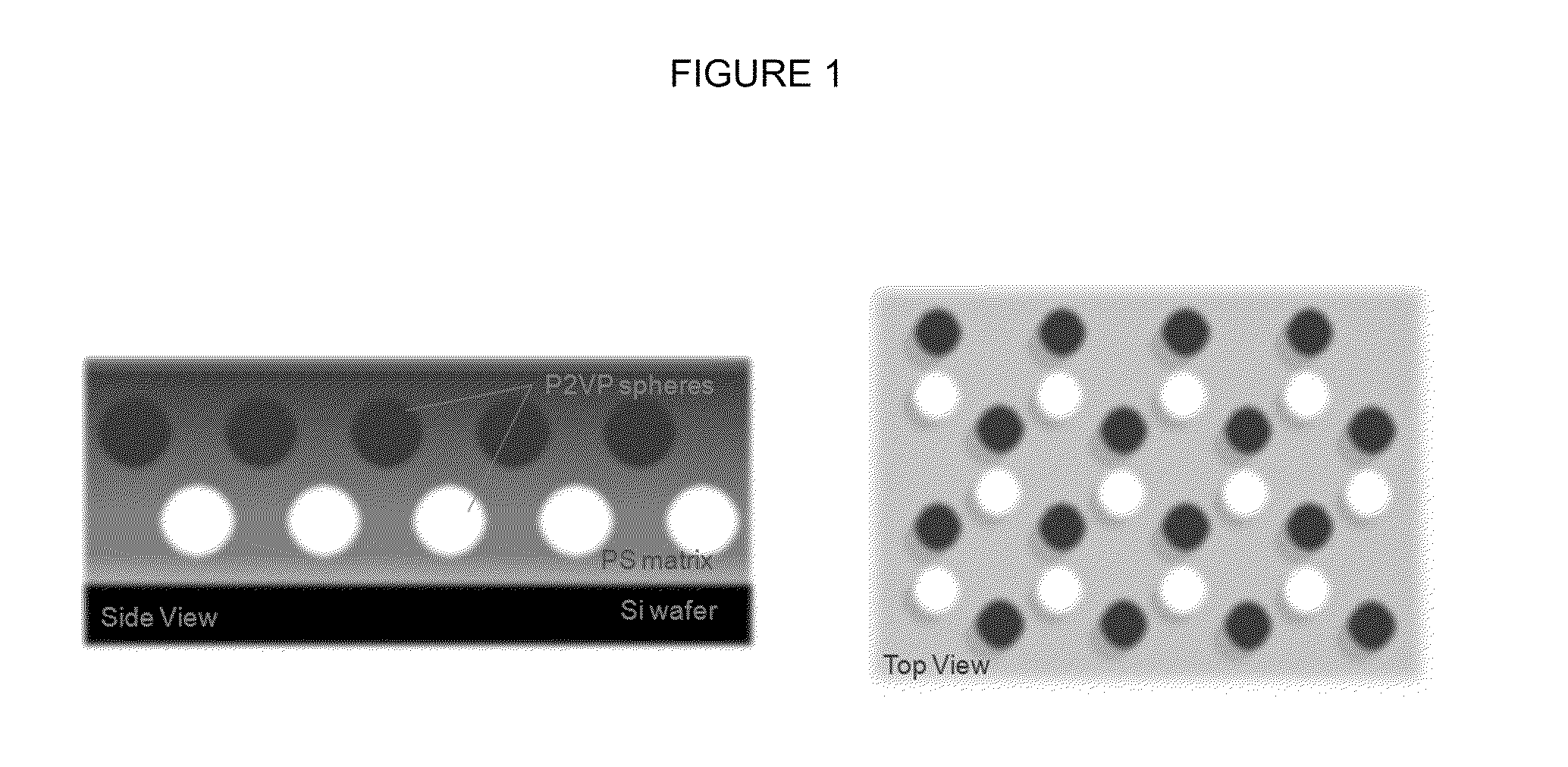Method for forming a block copolymer pattern
a technology of copolymer pattern and block, which is applied in the direction of plasma technique, transportation and packaging, chemical coating, etc., can solve the problems of not increasing the actual resolution of the polymer, and no system has been reported for increasing the feature density of the polymer. , to achieve the effect of increasing the feature density of the block copolymer pattern on the substrate and increasing the thickness of the film
- Summary
- Abstract
- Description
- Claims
- Application Information
AI Technical Summary
Benefits of technology
Problems solved by technology
Method used
Image
Examples
example 1
Generation of a Density Doubled Platinum Nanoparticle Array
[0107]A silicon wafer (, n-type, B-doped, ρ=0.01-0.02 Ωcm) was diced into ˜1 cm2 pieces and degreased in a methanol ultrasonic bath for 15 min followed by drying in a nitrogen stream. The substrates were then cleaned via a standard RCA clean: the diced wafers were first immersed in a hot solution of H2O:NH4OH:H2O2 (5:1:1) for 15 min and then rinsed with excess Millipore water. They were then immersed in a hot H2O:HCl:H2O2 (6:1:1) solution for 15 min and re-rinsed with excess Millipore water. Following this cleaning procedure, the wafers were visibly hydrophilic. Water on the surface was immediately removed with a stream of nitrogen before polymer spin-coating.
[0108]The block copolymer polystyrene (PS-125k)-b-poly-2-vinylpyridine (P2VP-58.5 k) was dissolved in toluene at 70° C. to make 1 wt %-2 wt % solutions and allowed to cool to room temperature. A volume of 10 μL of the polymer solution was then dropped onto the cleaned S...
example 2
Generation of a Density-Doubled Array of Platinum Nanolines
[0111]A silicon wafer (, n-type, B-doped, 1-10 ohmcm) was diced into ˜1 cm2 pieces and degreased in a methanol ultrasonic bath for 15 min followed by drying in a nitrogen stream. The substrates were then cleaned via a standard RCA clean: the diced wafers were first immersed in a 80° C. solution of H2O:NH4OH:H2O2 (5:1:1) for 15 min and then rinsed with excess Millipore water. They were then immersed in a hot H2O:HCl:H2O2 (6:1:1) solution for 15 min and re-rinsed with excess Millipore water. Following this cleaning procedure, the wafers were visibly hydrophilic; water on the surface was immediately removed with a stream of nitrogen before polymer spin-coating.
[0112]The block copolymer PS(125k)-b-P2VP(58.5 k) was dissolved in toluene at 70° C. to make 1 wt %-2 wt % solutions and allowed to cool to room temperature. A volume of 10 μL of the polymer solution was then dropped onto the cleaned Si substrate and spin-coated at 4000 r...
example 3
Generation of a Density-Doubled Array of Palladium Nanolines
[0116]A silicon wafer (, n-type, B-doped, 1-10 Ωcm) was diced into ˜1 cm2 pieces and degreased in a methanol ultrasonic bath for 15 min followed by drying in a nitrogen stream. The substrates were then cleaned via a standard RCA clean: the diced wafers were first immersed in a 80° C. solution of H2O:NH4OH:H2O2 (5:1:1) for 15 min and then rinsed with excess Millipore water. They were then immersed in a hot H2O:HCl:H2O2 (6:1:1) solution for 15 min and re-rinsed with excess Millipore water. Following this cleaning procedure, the wafers were visibly hydrophilic; water on the surface was immediately removed with a stream of nitrogen before polymer spin-coating.
[0117]The block copolymer PS(125k)-b-P2VP(58.5 k) was dissolved in toluene at 70° C. to make 1 wt %-2 wt % solutions and allowed to cool to room temperature. A volume of 10 μL of the polymer solution was then dropped onto the cleaned Si substrate and spin coated at 4000 rp...
PUM
| Property | Measurement | Unit |
|---|---|---|
| thickness | aaaaa | aaaaa |
| thickness | aaaaa | aaaaa |
| density | aaaaa | aaaaa |
Abstract
Description
Claims
Application Information
 Login to View More
Login to View More - R&D
- Intellectual Property
- Life Sciences
- Materials
- Tech Scout
- Unparalleled Data Quality
- Higher Quality Content
- 60% Fewer Hallucinations
Browse by: Latest US Patents, China's latest patents, Technical Efficacy Thesaurus, Application Domain, Technology Topic, Popular Technical Reports.
© 2025 PatSnap. All rights reserved.Legal|Privacy policy|Modern Slavery Act Transparency Statement|Sitemap|About US| Contact US: help@patsnap.com



